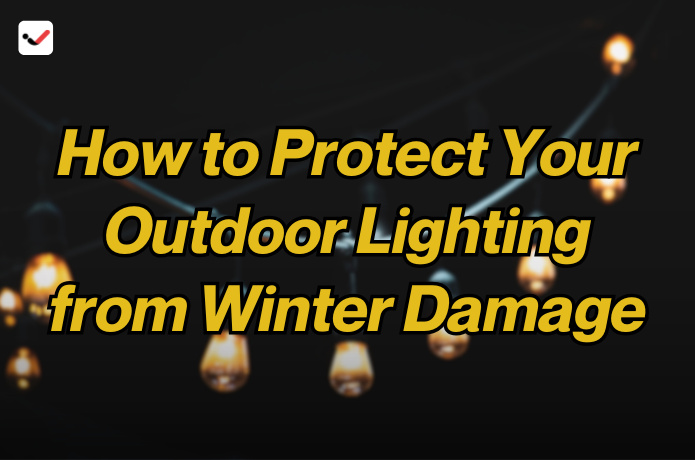How to Protect Your Outdoor Lighting from Winter Damage
How to Protect Your Outdoor Lighting from Winter Damage

Winter can be a challenging season for homeowners, especially when it comes to maintaining outdoor features like lighting. The cold, snow, and ice can cause significant wear and tear on outdoor lighting systems, leaving them damaged or even completely unusable by the time spring arrives. Outdoor lighting not only enhances the beauty of your property but also provides safety and security. Therefore, it's important to take measures to protect your outdoor lights from the harsh winter elements.
The good news is that with a little preparation and the right maintenance practices, you can protect your outdoor lighting system from winter damage. This article will explore several effective ways to shield your outdoor lighting from the cold, snow, and ice. By following these tips, you can ensure that your lights stay in great condition throughout the winter and remain fully functional when the warmer months return.
1. Choose Weather-Resistant Outdoor Lights
One of the first steps to ensuring the longevity of your outdoor lighting system is to invest in weather-resistant lights. Not all outdoor lighting fixtures are designed to withstand extreme cold, snow, or rain. When purchasing new lights, look for ones that are specifically rated for outdoor use and are designed to handle harsh weather conditions. Lights labeled with an "IP" rating, such as IP65 or IP67, are more resistant to water and dust, making them ideal for winter weather.
LED lights are also a great choice for winter because they are more durable and energy-efficient than traditional incandescent lights. LED fixtures tend to have a longer lifespan and can handle temperature fluctuations better. Additionally, make sure the bulbs and fixtures you select are rated for low temperatures to prevent cracking or damage due to freezing conditions.
2. Keep Lights Clean and Free of Snow and Ice
During the winter months, snow and ice can accumulate on your outdoor lighting fixtures, causing them to malfunction or become permanently damaged. To avoid this, regularly check your outdoor lights for buildup. Use a soft brush or cloth to remove snow, ice, or debris from around the bulbs and wiring. Be sure to clear off the fixtures, as well as the areas around your lighting posts or garden lights.
It's also important to keep the light covers or lenses clean. Snow and ice can obstruct the light output and reduce the effectiveness of your lighting. Regular cleaning can ensure that your lights shine brightly and continue to provide adequate illumination. However, always allow the lights to cool down before cleaning them to avoid any potential damage.
3. Install Protective Covers for Outdoor Lights
If you live in an area that experiences heavy snow or ice, investing in protective covers for your outdoor lights can help shield them from the harsh elements. Protective covers are designed to fit over your lighting fixtures and prevent snow, ice, and rain from coming into contact with them. These covers are available in various sizes and shapes to fit different types of outdoor lights, from post lights to landscape lights.
Choose covers made from durable materials, such as heavy-duty plastic or waterproof fabric, that can withstand winter weather. Make sure the covers are breathable to prevent moisture buildup inside, which could lead to rust or mold growth. While covers are not a guarantee against damage, they provide an extra layer of protection for your outdoor lighting system during the winter months.
4. Use Timers and Motion Sensors to Limit Exposure
Exposing your outdoor lights to constant cold weather can increase the risk of damage. To reduce the wear and tear on your lighting system, consider using timers and motion sensors to control when your lights are on. Timers allow you to set your lights to turn off after a certain period, preventing them from running for extended hours in freezing temperatures.
Motion sensors can be used for security lighting, ensuring that your lights only come on when needed. This can help minimize the exposure of your lights to winter weather, saving energy and preventing unnecessary strain on your lighting fixtures. Both timers and motion sensors are simple and effective ways to protect your outdoor lighting system while still providing security and ambiance.
5. Check Wiring and Electrical Connections
Frozen or damaged wiring is one of the most common issues that can arise with outdoor lighting during winter. When water from melted snow or ice seeps into the wiring, it can freeze and expand, causing cracks or shorts in the electrical connections. Over time, this can lead to malfunctioning or completely non-functional lights.
To avoid this, inspect the wiring and connections of your outdoor lighting system before the winter weather hits. Ensure that all wires are properly insulated and that there are no exposed wires that could come into contact with snow or water. You can purchase waterproof electrical boxes and connectors to keep the wiring safe from the elements. If you are unsure about the condition of your electrical system, it’s always best to consult a licensed electrician to ensure everything is properly protected.
6. Elevate Lights Above Snow Level
If your outdoor lighting fixtures are located near the ground, they are at a higher risk of damage from snow accumulation. When heavy snow falls, it can bury your lights and cause them to become covered, making them harder to access for maintenance or cleaning. This can also lead to the lights getting stuck in the snow or ice, which could damage the fixtures.
To avoid this, consider elevating your outdoor lights above the expected snow level. Installing your lights on poles or mounting them higher up on structures can help keep them above snowdrifts and prevent them from being covered by the snow. This will make it easier to maintain your lights throughout the winter and ensure that they continue to work properly.
7. Remove Lights Before the Harshest Weather
If you live in an area that experiences extreme winter conditions with heavy snow, ice, or freezing temperatures, it may be worth removing your outdoor lights temporarily. While this may not be practical for all types of lighting, especially larger fixtures, smaller landscape lights and decorative string lights can be taken down and stored indoors during the harshest weather. Storing your lights indoors will protect them from direct exposure to freezing temperatures, which can cause cracking or other damage.
If you prefer not to remove your lights, ensure that they are properly protected with covers or stored in areas that are shielded from heavy snow and ice. When the weather improves, you can easily reinstall your lights and enjoy their benefits once again.
8. Consider Using Solar Lights
Another great option for outdoor lighting during the winter is solar-powered lights. Solar lights rely on sunlight to charge their batteries, which makes them less dependent on electrical connections. Since they don’t rely on wiring, they are less vulnerable to freezing or short circuits. Solar lights are a low-maintenance option that can be left outside all year without worrying about winter damage.
However, solar lights do require sufficient sunlight to function properly. If you live in a region with long periods of snow and cloudy weather, you may want to position the lights in areas where they can still get some sunlight. While solar lights may not be as bright as traditional electric lights, they offer a convenient and energy-efficient way to light up your outdoors in winter.
Protecting your outdoor lighting from winter damage is essential for keeping your home illuminated, safe, and beautiful during the colder months. By choosing weather-resistant lights, keeping them clean and covered, and maintaining their wiring and electrical connections, you can extend the life of your outdoor lighting system. Implementing smart controls like timers and motion sensors can also help reduce exposure to the elements. By taking these proactive steps, you’ll ensure that your outdoor lights continue to shine bright even in the harshest winter weather.

